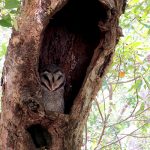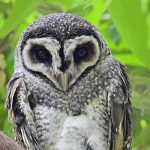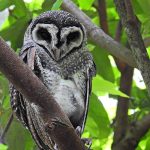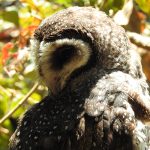LESSER SOOTY OWL
Secrets of a Silent Rainforest Hunter
As dusk cloaks the Australian rainforest in velvet darkness, a soft, haunting cry echoes beneath the towering canopy. Silently, a figure glides between ancient trunks and tangled vines. This is the Lesser Sooty Owl (Tyto multipunctata)—a remarkable creature whose story is woven into the depths of the northern Queensland rainforest. Beautifully elusive, this owl is not just a master hunter but a dedicated parent, ensuring the legacy of its kind continues in one of Australia’s most precious landscapes.
Physical Description
Gaze into the face of a Lesser Sooty Owl and you see a perfect circle—its round, silvery-grey facial disc fringed with darker feathers. Every part of its being is adapted to a life in perpetual twilight:
- Size: 32–38 centimetres tall, relatively small for an owl
- Plumage: Dappled soot-grey, peppered with fine white spots, blending seamlessly with shadow and moonbeams
- Eyes: Large and black, quietly capturing low light
- Talons: Strong and feathered, perfect for gripping prey
Rainforest Home and Range
Hidden amid the mossy giants and dense vegetation of the Wet Tropics and Atherton Tablelands in northern Queensland, the Lesser Sooty Owl thrives. Here, coolness lingers even in daylight, the air scented with wet earth and leaf litter. Old trees, draped in lichen and emerald moss, provide vital shelter and nesting sites.
| Region | Habitat Type |
|---|---|
| Northern Queensland | Tropical and subtropical rainforest |
Nocturnal Life and Diet
When night descends, the Lesser Sooty Owl becomes active. Flight is their art—owing to feathers modified for near-silent movement through dense forest.
- Hunting: Listens intently for the faintest sounds, tilting its head to dissect the rustle of a small mammal or the movement of an insect
- Diet: Focal prey includes small marsupials (like antechinus), native rodents, birds, and large insects
- Hunting Sequence:
- Perches motionless, senses attuned
- Locates prey by sound
- Swoops silently, talons extended
- Captures food with precision
The Intimate World of Breeding and Family
Breeding Season
From March to August, the rainforest witnesses the Lesser Sooty Owl’s most tender rituals. This chapter is a quiet testament to persistence, patience, and care.
Nesting and Courtship
- Nest Site: Selected hollows in ancient trees or the crevices of mossy rocks become cradles for the next generation
- Preparation: No complex construction—just a simple lining of leaves or bark, relying on the safety of the hollow itself
- Pair Bonding: Pairs reaffirm their bond with gentle preening, mutual calls, and food offerings, deepening trust as breeding nears
Egg to Owlet
- Clutch Size: Usually 1–2 eggs, well-spaced in their hidden chamber
- Incubation: The female stays with the eggs and emerging chicks for about 36 days, while the male is a tireless provider, hunting through the night
- Chick Care:
- Early Days: Chicks hatch blind, cloaked in soft down
- Feeding: Both parents share the growing task of feeding, with the female remaining close until the young are stronger
- Fledging: In 60–80 days, the young venture into the leafy world, climbing before they learn to fly
| Breeding Stage | Timing | Details |
|---|---|---|
| Courtship | Before nesting | Calling, preening, food sharing |
| Egg Laying | Mar–Aug | 1–2 eggs in a tree hollow or cave |
| Incubation | ~36 days | Female incubates, male provides food |
| Chick Development | 60–80 days | Intensive care, rapid growth |
| Fledging | After 2–3 months | Young leave nest, explore forest branches |
Voice of the Night
In the stillness of the forest, the Lesser Sooty Owl’s loud, piercing shriek stands out—a sound at once eerie and enchanting. It is both a declaration and a warning, marking territory and keeping contact between mates. For many, this call is the essence of the wild, a haunting sound woven through the silent canopy.
Unique Adaptations
- Silent Flight: Specialised wing feathers reduce noise
- Asymmetrical Ears: Pinpoint accuracy in locating prey by sound
- Rainforest Camouflage: Stealthy plumage makes them nearly invisible in dappled light and shadow
Conservation
With a deep dependence on old-growth trees and undisturbed rainforest, the Lesser Sooty Owl faces threats from logging, land clearing, and climate change. Their future—and the future of countless other rainforest species—rests in our hands. To protect the owl is to protect the intricate ecosystem that nurtures not just birds, but a symphony of wildlife and plants.
Why Their Story Matters
The Lesser Sooty Owl’s journey—from silent hunter to gentle parent—reveals the wonders and fragility of Australia’s natural world. To hear their call is to glimpse a hidden realm, and to sense the delicate balance that makes the rainforest flourish. Preserving their story enriches our own, reminding us of our role as stewards and storytellers for the wild heart of Australia.
Quick Facts
| Feature | Details |
|---|---|
| Scientific name | Tyto multipunctata |
| Size | 32–38 cm in length |
| Range | Northern Queensland rainforests |
| Diet | Small mammals, birds, large insects |
| Breeding | March–August, 1–2 eggs per clutch |
| Conservation | Threatened by habitat loss |
Let us listen, learn, and nurture the future of the Lesser Sooty Owl—guardian spirit of Australia’s living rainforests.






